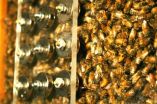(Press-News.org) Cultured mesenchymal stem cells can "feel" at least several microns below the surface of an artificial microfilm matrix, gauging the elasticity of the extracellular bedding that is a crucial variable in determining their fate, researchers reported today at the American Society for Cell Biology's 50th Annual Meeting in Philadelphia.
Controlling or predicting how stem cells differentiate into cells of a specific tissue type is a critical issue in the bioengineering of artificial tissue and in stem cell medicine.
To determine how deep a cell's sense of touch can reach, University of Pennsylvania researchers placed naive mesenchymal stem cells (MSCs) on microfilm matrices controlled for thickness and elasticity and bonded to rigid glass.
Amnon Buxboim, Ph.D., of the University of Pennsylvania and colleagues constructed these artificial bedding surfaces to mimic the extracellular matrix that stem cells "feel" as they differentiate.
They used naive MSCs as prototypical adherent cells, because they are particularly sensitive to micro-environmental factors such as elasticity or hardness as they differentiate.
By a variety of measures, the researchers concluded that MSCs can "feel" to several microns into compliant matrices. The stiffer the surface, the shallower the cells could feel; the softer the surface, the deeper they could "feel."
Because the matrices varied, the scientists were able to document significant differences between stem cells grown on varying stiffness and thickness that represent human tissue microenvironments ⎯ such as brain tissue, which is softer than muscle, which is softer than cartilage, which is softer than pre-calcified bone.
In previous studies, the researchers discovered that as tissue cells adhered to a soft natural extracellular matrix, they pulled and deformed the surface, actions that allowed the cells to use their sense of touch below the surface.
To determine how the thickness and stiffness of the microfilm affected the form of cells grown on top, they deployed a range of methods to document significant differences between stem cells grown on thin films versus thick films.
Cell shape was measured by confocal microscopy and micro-elasticity by atomic force microscopy. Cellular responses were analyzed in terms of morphology while cytoskeletal organization was mapped using non-muscle myosin assembly. Changes in gene expression were obtained by DNA microarray-based transcriptional analysis of the genome.
INFORMATION:
FOR MORE INFORMATION:
ASCB contacts:
Cathy Yarbrough
sciencematter@yahoo.com
858-243-1814 (cell)
215-418-5306 (Dec.11-16)
John Fleischman
jfleischman@ascb.org
513-929-4635 (before Dec. 11)
513-706-0212 (cell)
University of Pennsylvania contacts:
Amnon Buxboim, Ph.D.
University of Pennsylvania
215-898-4858
amnonb@sas.upenn.edu
Karen Kreeger
Senior Science Communications Manager
215-349-5658 (land)
215-459-0544 (cell)
karen.kreeger@uphs.upenn.edu
Dr. Buxboim will present, "How Deeply Cells Feel: Regulation of Cellular Organization and Differentiation by Matrix," Monday, Dec. 13, 2010, 1 to 2:30 p.m. session, Extracellular Matrix and Signaling 1; Exhibit Halls A/B/C; Abstract 1361 on Board B660
Co-authors:
D.E. Discher of Physics and Astronomy, and E.C. Eckels and D.E. Discher of Chemical and Biomolecular Engineering, University of Pennsylvania
Funding:
This research was supported by NIH R01-HL062352, R21-AR056128, P01-DK032094, Human Frontier Sciences Program Grant, and NSF–NSEC NanoBio Interface Center.
END
Deleting the receptor, not the protein ghrelin itself, turns up the body's fat-burning thermostat, giving aging mice an exothermic boost toward a svelte physique, researchers reported at the American Society of Cell Biology's 50th Annual Meeting in Philadelphia.
The protein's receptor, growth hormone secretagogue receptor (GHS-R), might make a better target than ghrelin for treating obesity, according to Yuxiang Sun, M.D., Ph.D., of the Baylor College of Medicine in Houston, TX.
Sun said that experimentally deleting the receptor from the body cells of laboratory mice ...
Long considered a freewheeling loner, the Trypanosoma brucei parasite responsible for African sleeping sickness has revealed a totally unexpected social side, opening a potential chink in the behavioral armor of this and other supposedly solitary human parasites, according to research presented at the American Society for Cell Biology's 50th Annual Meeting in Philadelphia.
"The concept of bacteria acting as groups of cells communicating and cooperating with one another has had a major impact on our understanding of bacterial physiology and pathogenesis, but this paradigm ...
Small details between "in vivo" and "in vitro" studies make for big differences in understanding diabetes and other secretory dysfunctions
Exocytosis, the fundamental process by which cells secrete hormones such as insulin and other useful biological substances, is regulated far differently in life than in laboratory tissue cultures and explanted organs, according to research presented today at the American Society of Cell Biology's 50th Annual Meeting in Philadelphia.
The unexpected findings that exocytosis regulation "in vivo" is not the same as the process long studied ...
Researchers have provided the first thorough mechanistic account of how a genetic defect leads to malignant hypothermia (MH) and central core disease (CCD), rare genetic skeletal muscle disorders. The study appears in the January issue of the Journal of General Physiology (www.jgp.org).
Mutations in the type 1 ryanodine receptor (RYR1), the calcium release channel of the sarcoplasmic reticulum (SR) activated during skeletal muscle excitation-contraction (EC) coupling, give rise to CCD. One of the most common CCD-causing mutations is Ile4895Thr. Now, Robert Dirksen (University ...
ST. PAUL, Minn. – Many people with incurable brain tumors use alternative therapies, such as taking vitamins and homeopathy, in addition to their conventional treatments, according to a study published in the December 14, 2010, print issue of Neurology®, the medical journal of the American Academy of Neurology.
About 40 percent of brain tumor patients in the study used alternative therapies including homeopathic remedies, vitamin supplements and psychological therapy.
"The use of these alternative treatments may be largely overlooked and underestimated," said study ...
Folic acid can reduce birth defects including neural tube defects, congenital heart disease and oral clefts but some speculate high intakes of folic acid may be associated with adverse events such as colorectal cancer, states an article in CMAJ (Canadian Medical Association Journal) (pre-embargo link only) http://www.cmaj.ca/embargo/cmaj100568.pdf.
This study, conducted by researchers at Children's Hospital of Eastern Ontario Research Institute and The Hospital for Sick Children, is the first of its kind in more than three decades, to examine the folate status of Canadians ...
Disease-management programs, which may include patient education, psychological intervention, dietary education, self-monitoring and telemedicine, can improve diabetes care, states an article in CMAJ (Canadian Medical Association Journal) (pre-embargo link only) http://www.cmaj.ca/embargo/cmaj091786.pdf.
The study, by French researchers, included 41 randomized controlled trials published between 1990 and 2009 with a total of 7013 patients.
The findings showed that disease-management programs are more effective than usual care in reducing glycated hemoglobin levels ...
VIDEO:
This movie spotlights one waggle dance by a forager that had been sleep-deprived the
previous night. The average dance angle of this dance is superimposed over the dancer and variance around...
Click here for more information.
AUSTIN, Texas—In the busy world of a honey bee hive, worker bees need their rest in order to best communicate the location of food to their hive mates, research from The University of Texas at Austin shows.
"When deprived of sleep, humans ...
SAN ANTONIO, Texas, U.S.A. (Dec. 13, 2010) — Scientists at the UT Health Science Center San Antonio restored learning and memory in an Alzheimer's disease mouse model by increasing a protein called CBP. Salvatore Oddo, Ph.D., of the university's Department of Physiology and Barshop Institute for Longevity and Aging Studies, said this is the first proof that boosting CBP, which triggers the production of other proteins essential to creating memories, can reverse Alzheimer's effects.
The finding, reported this week in Proceedings of the National Academy of Sciences, provides ...
Boston, Mass. – It's widely recognized that fragmentation of medical information is a problem in health care, but the extent of the problem and how many patients may be at risk haven't been well quantified. In a new retrospective study, researchers at Children's Hospital Boston looked at adult acute care in Massachusetts and found that of 3.6 million adults visiting an acute care site during a five-year period, almost a third sought care at two or more different hospitals. These patients accounted for more than half of all acute care visits in the state, as well as more ...

